
An apricot is a fruit, or the tree that bears the fruit, of several species in the genus Prunus.

Pinus sibirica, or Siberian pine, in the family Pinaceae is a species of pine tree that occurs in Siberia from 58°E in the Ural Mountains east to 126°E in the Stanovoy Range in southern Sakha Republic, and from Igarka at 68°N in the lower Yenisei valley, south to 45°N in central Mongolia.
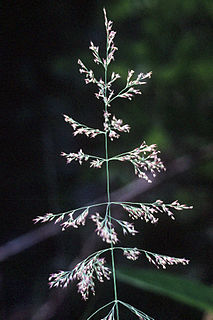
Calamagrostis is a genus of flowering plants in the grass family Poaceae, with about 260 species that occur mainly in temperate regions of the globe. Towards equatorial latitudes, species of Calamagrostis generally occur at higher elevations. These tufted perennials usually have hairless narrow leaves. The ligules are usually blunt. The inflorescence forms a panicle. Some may be reed-like.
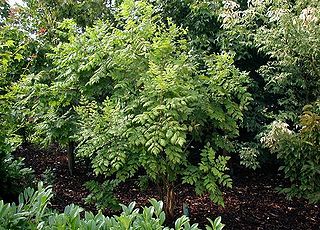
Koelreuteria is a genus of three species of flowering plants in the family Sapindaceae, native to southern and eastern Asia.

Orobanche is a genus of over 200 species of parasitic herbaceous plants in the family Orobanchaceae, mostly native to the temperate Northern Hemisphere. Some species formerly included in this genus are now referred to the genus Conopholis. The broomrape plant is small, from 10–60 cm tall depending on species. It is best recognized by its yellow- to straw-coloured stems completely lacking chlorophyll, bearing yellow, white, or blue snapdragon-like flowers. The flower shoots are scaly, with a dense terminal spike of between ten and twenty flowers in most species, although single in O. uniflora. The leaves are merely triangular scales. The seeds are minute, tan-to-brown, and blacken with age. These plants generally flower from late winter to late spring. When they are not flowering, no part of the plants is visible above the surface of the soil.
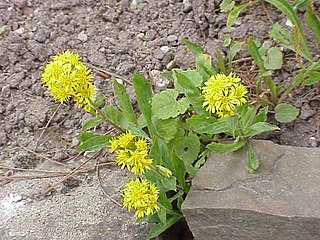
Solidago virgaurea, the European goldenrod or woundwort, is an herbaceous perennial plant of the family Asteraceae. It is widespread across most of Europe as well as North Africa and northern, central, and southwestern Asia. It is grown as a garden flower with many different cultivars. It flowers profusely in late summer.

Xerochrysum is a genus of flowering plants native to Australia. It was defined by Russian botanist Nikolai Tzvelev in 1990, preceding Bracteantha which was described the following year. A 2002 molecular study of the tribe Gnaphalieae has indicated the genus is probably polyphyletic, with X. bracteatum and X. viscosum quite removed from each other.

Deschampsia is a genus of plants in the grass family, commonly known as hair grass or tussock grass. The genus is widespread across many countries.

Claytonia sibirica is a flowering plant in the family Montiaceae, native to the Commander Islands of Siberia, and western North America from the Aleutian Islands and coastal Alaska south through the Queen Charlotte Islands, Vancouver Island, Cascade and Coast Ranges, to a southern limit in the Santa Cruz Mountains. Populations are also known from the Wallowa Mountains, Klamath Mountains, northern Idaho, and The Kootenai. A synonym is Montia sibirica. The plant was introduced into the United Kingdom by the 18th century, where it has become very widespread.

Iris sibirica, is a species in the genus Iris. It is a rhizomatous herbaceous perennial, from Europe and Central Asia. It has long green grass-like leaves, tall stem, 2–5 violet-blue, to blue, and occasionally white flowers. It is cultivated as an ornamental plant in temperate regions.

Achnatherum is a genus of plants which includes several species of needlegrass. Several needlegrass species have been switched between Achnatherum and genus Stipa; taxonomy between the two closely related genera is still uncertain.
Knorringia is a genus of plants in the family Polygonaceae. It is native to Central Asia and Siberia.
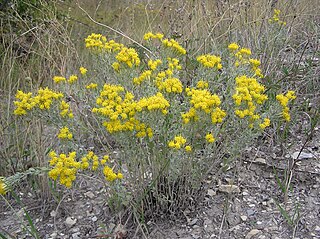
Galatella is a genus of flowering plants in the daisy family, native to Europe, Asia, and northern Africa.
Australopyrum is a genus of plants in the grass family, native to Australia, New Zealand, and New Guinea.

Ajania is a genus of flowering plants in the daisy family, described as a genus in 1955. The genus is native to temperate Asia, primarily Russia and China. It is named after the Russian port city Ayan in the Khabarovsk Krai region of the Russian Far East, on the coast of the Sea of Okhotsk.
Pseudohandelia is a genus of flowering plants in the chamomile tribe within the daisy family.

Erannis jacobsoni, or Jacobson's spanworm, is a moth of the family Geometridae. The species was first described by Alexander Michailovitsch Djakonov in 1926. It is found in Europe and Asia.
Hyalopoa is a genus of Asian plants in the grass family.
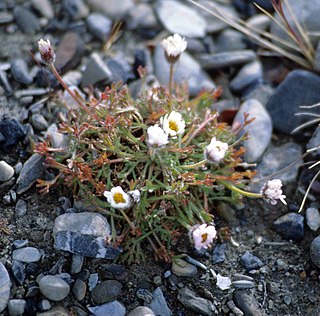
Arctanthemum integrifolium, the entire-leaved daisy, is a subarctic species of plant in the sunflower family. It grows in Alaska, northern Canada, Peary Land in northern Greenland, and the East Chukotka region of eastern Russia.
Najas tenuissima is a species of flowering plant belonging to the family Hydrocharitaceae.














